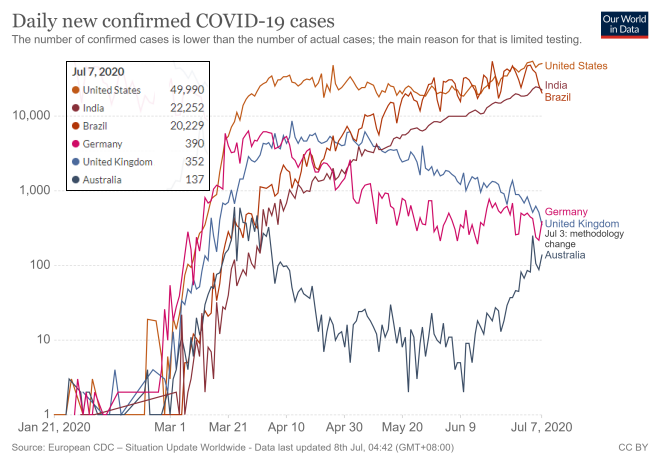A snapshot of overnight moves and a look to the upcoming Australian session for 8 July.
Market Moves
Wrap
Overnight, US markets were broadly lower. The tech-heavy Nasdaq was down 0.9%, whilst the benchmark S&P500 fell 1.1%, and the Dow Jones Industrial Index fell 1.5%. Importantly, the so-called 'fear gauge', the volatility index (VIX), jumped 5% signalling investors were becoming increasingly nervous.
US investors once again focussed on rising covid-19 cases. So far in July, 18 states have reported record increases in new cases. Yesterday, the daily new cases count took a turn back up towards the 50k per day rate, after a few days of declines.

Metals prices on the LME were generally modestly higher. 6 workers at Glencore's Copper Company mine in Democratic Republic of Congo's Lualaba province tested positive for covid-19. Whilst not a big producer by global standards, the announcement highlights potentially how fragile metals supply might be going forwards as many developing countries grapple with the virus.
Iron ore prices moved on a on a similar theme. The $USD priced contract rose 1.4% on news that shipments from Brazil were lower in June.
Spot gold hit its highest level since November 2011, with spot gold up 0.6% and now trading at US$1794.29 an ounce. Gold traders are betting on the inflationary implications of unprecedented levels of central bank stimulus.
Crude oil was down only 0.6% despite markets turning risk off, and as the US Energy Information Administration (EIA) announced that US crude output in 2020 would decline in less than previously forecast.
Energy traders instead chose to focus on the EIA forecast that global oil demand would recover through the end of 2021. "Global oil demand continues to recover faster than previously estimated," Linda Capuano, EIA administrator said.
Brent crude rose 0.3% and Natural Gas had an even stronger session, closing 2.8% higher.
The ASX200 Share Price Index was 30 points lower yesterday, closing the evening session at 5959. That's a 54 point discount to yesterday's ASX 200 close of 6012. This implies that the ASX 200 should trade roughly 1% lower at the open.
AU Companies
The best performer from the ASX 200 yesterday was St Barbara Mines (SBM) which rose 10.3% after providing a production update. St Barbara announced full year gold production of 381,887 ounces, in line with its guidance of 370,000 to 400,000 ounces.
Commenting on the results, St Barbara managing director and CEO Craig Jetson said, "The quarter indicated the potential of the company, with quarterly production of over 100,000 ounces for the first time in two years. 2020 marks a new era in the evolution of St Barbara."
Also updating the market was "the other" buy now pay later plater, Sezzle Inc (SZL). The company said that its strong form continued in the second quarter with stellar underlying merchant sales (UMS) growth.
Sezzle reported underlying merchant sales (UMS) of US$188 million (A$272.3 million) for the quarter, up 58% on a qoq basis, and up 349% yoy. It had 1.48m active customers on its platform at the end of the quarter, up 28% on a qoq basis, and up 243% yoy, whilst active merchants numbers were up 27% and 219% respectively. Importantly, repeat usage also improved to 87.5% in June compared to 77.2% in June 2019.
Sezzle’s CEO Charlie Youakim commented: "Our strong performance in Q2 is reflective of an improving consumer profile…The undercurrent of organic growth is exciting." He predicted that the gains in repeat customer usage would be key drivers to lower loss rates and greater margin going forwards.
Today, investors will focus on trading updates from IGO. The nickel and base metals miner reported that full year production for FY20 from its Nova operation exceeded guidance for all metals, while Tropicana FY20 gold production was within the guidance range.
IGO’s Managing Director & CEO Peter Bradford said: "FY20 was a year of unique challenges…but the Company has demonstrated outstanding resilience and adaptability while achieving excellent operational performance."
Macro Economy
Australia
As widely expected the Reserve Bank of Australia (RBA) held its cash rate at an all-time low on Tuesday at 0.25%.
Despite new Melbourne lockdowns, the RBA Governor Philip Low sounded cautiously optimistic. "Conditions have, however, stabilised recently and the downturn has been less severe than earlier expected," Lowe said.
"While total hours worked in Australia continued to decline in May, the decline was considerably smaller than in April and less than previously thought likely. There has also been a pick-up in retail spending in response to the decline in infections and the easing of restrictions in most of the country."
Still, he noted that the RBA would keep interest rates low "as long as it is required." This is because the Australian economy was in the midst of its biggest contraction since the 1930s. Low noted that the nature and speed of the economic recovery remained "highly uncertain."
The RBA did not make a mention of the recent jump in covid-19 cases in Melbourne.
The government will publish a "mini-budget statement" on July 23 setting out plans for fiscal stimulus measures.
Back